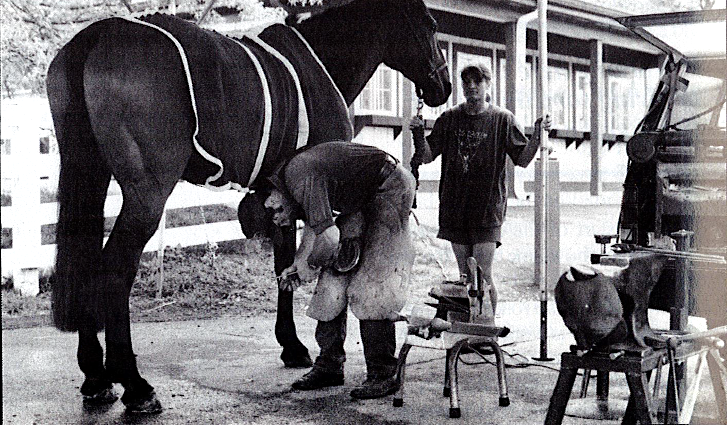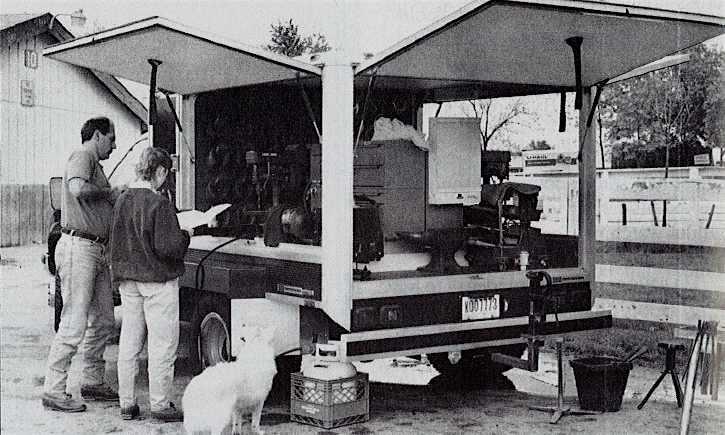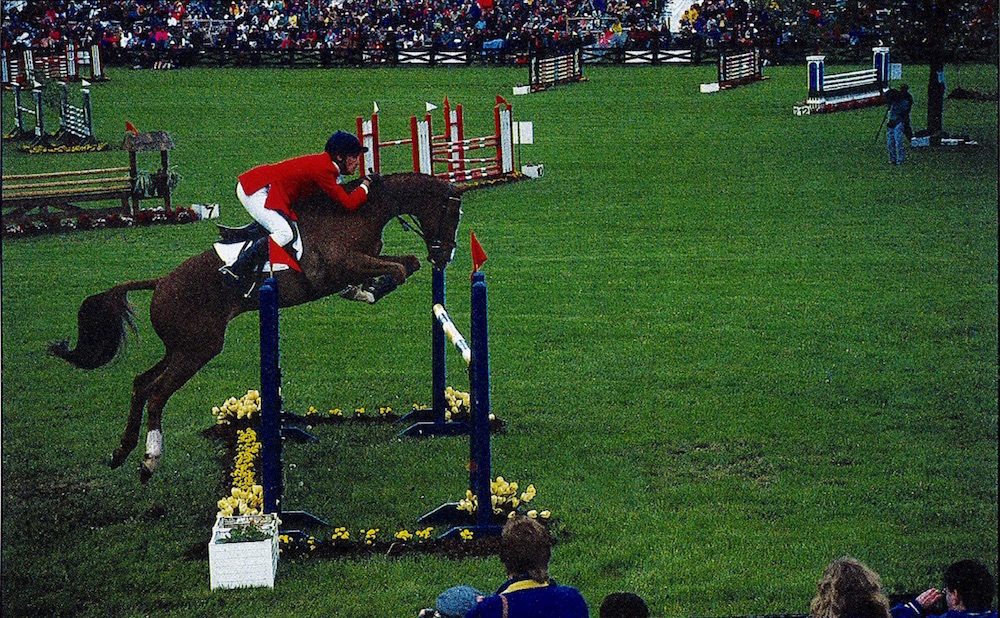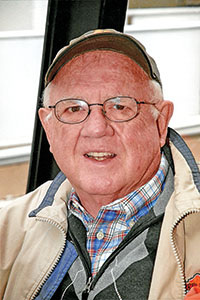Pictured Above: Go with studs or no studs? That was a key question, which the 3-day riders had to decide before entering the wet show jumping ring.
The work goes in spurts. Sometimes, you can be extremely busy. At other times, you can be bored out of your mind.
That’s the way shoeing went for five veteran farriers who worked the 1994 Rolex Kentucky 3-Day Event held last spring at the Kentucky Horse Park complex in Lexington, Ky.
The event is a three-star CCI (Concours Complet Internatione) event recognized by the world-wide Federation Equestre Internationale (FEI). It also served as a qualifying competition for the 1994 3-Day World Championships at The World Equestrian Games in The Netherlands.
The Rolex included dressage, endurance (roads and tracks plus cross-country) and stadium jumping.
To make sure each horse is in the necessary condition to begin the competition and continue the successive tests, animals were examined upon arrival and again prior to the dressage test, during the 10-minute halt before the start of cross-country, after cross-country and again before the start of the stadium jumping.
Five veteran farriers made up the Rolex farrier committee, under the supervision of Jeanene Tessari of Lexington, Ky. Near the barns, a shaded area was set up under a tent (needed to keep away rain at this event) and one or more farriers were stationed here from Wednesday through Saturday. This location was close enough to the dressage ring so competitors could bring problem horses over on Thursday and Friday.
For the Saturday endurance phase, farriers were stationed in the “authorized help” area at the end of the roads and track course.
At the end of the long road course, there was a mandatory vet check and cooling off period for the horses. “Two farriers were stationed there who can renail a loose shoe or replace a missing shoe,” Tessari says. “Later, farriers back at the stables can work on the horses that need more care.”
Here’s how the week went for these farriers at last spring’s 1994 Rolex.
WEDNESDAY...
Today, it was fairly warm and cloudy.
Ralph “Trip” Bisenius of Lexington, Ky., showed up for his Rolex farrier committee assignment and did some repair work on several early arrivals. But shoeing work was slow.
“I did some hoof reconstruction work and nailed a few shoes back on,” he says. “Several horses had quarters which had been ripped off and the horse would lose a shoe and take the quarter with it.
“With a regular client, I’d nail the shoe back on and come back later to work. But here, we’ve got to come up with an immediate solution.”
He used Vet-Tek 8200 hoof repair by Duramix to reconstruct these quarters. The black urethane composition comes in 6-oz. packages (enough to do two feet) and Bisenius says he’s had plenty of success with it.
THURSDAY…
The air was warm and there was some rain as the dressage tests got underway.
There was no hoof repair work to do — only a few shoes to renail. So Bisenius kept busy by talking with friends and making shoes for his regular farrier practice.
He says most top riders travel with extra shoes for their horses and bring them to the farrier on the show grounds when there is a problem. St. Croix and Kerckhaert shoes are among the most popular for these 3-day horses.
However, this afternoon a woman brought over a set of Arthur Cottom shoes from England to be tapped for studs just in case she decided to use them the next day.
Spare Shoes Needed
“With my regular sport horse clients, I often make a new set of bar shoes and put them on the horse before it leaves,” says Bisenius. “Then I give them the old shoes to take along as a spare set, just in case they lose a shoe.”
Talking about 3-day event horses, Bisenius says feet can be a big problem. “Riders often have a horse with 2- or 3-week-old shoes without any nail heads left,” he says. “They often want us to renail the old shoes, quickly fix the problem and plan to reshoe the horse when they get back home.”
“These horses eat well, but take a real pounding on the hard ground. The horn collapses and gets shelly and brittle because of being wet all the time. Underslung and underrun heels are a common problem.
“Riders think egg bars are the fashionable shoe to use these days with 3-day eventers. They often have an egg bar on all four feet, but it definitely won’t solve all the problems we see.”
A fourth generation farrier, Bisenius cuts each clinch very carefully when shoeing these horses.
“When resetting shoes, I pull the nails carefully and normally go with a nail one size larger in the same holes when putting the shoe back on,” he explains. “Most shoes are normally punched for E-style nails — we use E-4 and E-5 slim nails most often.”
However, he sees some shoes made for E-head nails used on horses coming in from all around the world, which have been nailed with city head nails.
FRIDAY…
The second day for dressage testing turns cold and rainy.
Joining Tessari and Bisenius in manning the farrier tent are Kevin Curtis of Centerville, Ohio, and Hank Heitzberger of Columbus, N.C.
A horse comes in with a Grand Circuit treatment, which had given out in the horn area and around the nail holes. The farriers rebuilt the hoof.
One rider asked the farriers to make a French bar shoe. Other riders come in with nail heads worn off shoes, often due to the wrong nails having been used.
The Canadian team coach, who has eight horses entered in the Rolex, Jenette L. Enflau, admits not knowing the farriers at events often seems like a risk. But she realizes a trainer often can be surprised by the talents shown by show farriers.
She brings a horse with some hoof problems out, asks the farriers for an opinion and likes what she hears.
“We are going to go with your ideas because your observations about trimming and shoeing this underslung heeled horse seem to be right on,” she tells them. “The horse lost two shoes going to another 3-day event and he’s not going to be going home from here, so we need to get him shod.”
Later, she adds “I know the importance of a farrier to these horses. In fact, he’s more important than the veterinarian in determining the horse’s 3-day success.”
The farriers like to look at how the foreign horses are shod. “I can see U.S. horses all day long in my regular shoeing work,” says Curtis.
Big On Studs
“The bigger the studs, the better they will be today,” says Bisenius late in the morning. “There’s lots of slop out there in the dressage ring and it is getting worse. The biggest concern is in the warmup area. After that, the actual dressage ring isn’t that bad.”
Bisenius says 3-day riders are big on using studs, but they have to be used correctly to have any value. Here at Kentucky Horse Park, the dressage rings have wet, loose sand and clay. Tomorrow’s cross country course will likely be wet and slick on top of clay and a number of shoes will be lost by the horses.
Because of the wet conditions and the wet clay, most riders did not use studs in today’s dressage phase.
“In the roads and tracks, cross-country and stadium jumping phases, most horses need some traction device,” says Bisenius. “I see more horses in these events injured from slipping than from using traction devices. Big, long-pointed studs are usually needed.”
Sometimes, a show farrier sees a broken T-tap left in the shoe. “I had one case where the stud ran into the hoof — not the shoe,” adds Bisenius.
To hold studs in place, Bisenius wraps Teflon thread tape around the stud before screwing it into the shoe. While this can make it difficult to get the stud in the shoe, it really helps with directional studs.
Here’s what Bisenius would recommend for the 3-day events at last spring’s Kentucky Horse Park under extremely wet conditions.
- Dressage: “I’d go with small posted studs in back and road studs in front,” he says. “I might use a longer pointed stud on the outside of the back shoes, which I learned from the success the Germans have had.”
- Roads And Tracks, Plus Cross-Country: “I’d go with a large block or very large pointed stud back. I’d use a small pointed stud front and avoid road or grass studs.”
-
Stadium Jumping: “I’d go with the same studs as with cross-country since the grass jumping course has some banks.
But I’d want to see what the weather will be and how much the shoe jumping course is torn up by Sunday afternoon. You may want to use a heavier, more blockier stud late in the day.”
While some riders or farriers might disagree, Bisenius says these recommendations are based on his knowledge of the Kentucky Horse Park course. “The various courses may be wet, but they are still hard underneath,” he says. “I want studs that cut into the ground at all times. Problems with the suspensory ligaments can be a big concern when running here.”
Farriers Have The Answers!
Captain Mark Phillips, the well-known Olympic 3-day medalist from Great Britain, serves as Chef’d d’Equipe and technical advisor for the U.S. Equestrian team.
When it comes to shoeing 3-day horses, he relies 100% on the expertise of farriers. It’s important, he maintains, to shoe the horse — not to shoe for the rider or for a particular event.
Even though it’s muddy in the dressage ring, Phillips didn’t recommend using studs today. He felt they definitely would be needed on the grass courses over the next 2 days.
“You have to remember a stud is only an aid,” he says. “The choice varies according to the course conditions, the weather and what each rider feels will help their horse.
“If a rider makes a bad move out on the course, a stud isn’t going to help. What is more important is how the rider keeps the horse on its feet.”
Veteran 3-day rider Denise Rath says her horse ran into some bad footing probles here when the previous fall without studs and will definitely need them this weekend. “There is hard packed soil on this course under the wet sod,” says the Great Falls, Va., competitor. “We will use a little bigger bullet (stud) that is pointed on the cross-country course.”
SATURDAY…
The day starts cool and cloudy with a few dark clouds. By noon, it’s raining cats and dogs!


In the “authorized help” area of the roads and tracks course, Bisenius has parked his farrier truck and is relaxing while watching for possible shoeing concerns.
He says another good idea is to have Easy Boots on hand out on the course. “If a horse loses a shoe on the course, they can slap on an Easy Boot to keep him going,” says Bisenius. “Then they can put a new shoe on the horse when they get to the 10-minute box.”
Later, in the 10-minute rest and vet check area where horses are examined prior to the start of the cross-country phase, Tessari shows me what the two farriers do.
“Unlike out on the roads and tracks course where Trip is working, you have time to get any needed shoeing work done — up to 10 minutes,” she says.
“Up here, you may find shoes are lost, studs are jammed in the taps, studs need to be tightened or changed, replacement shoes don’t fit or the horse has lost part of the hoof.
“Riders don’t want any excuses — they just want you to fix their horse fast, even in today’s rainy weather.”
Fast Paced, Wet Work
Heintzberger shod hunters and jumpers for 18 years in California and then moved to Kentucky where he worked with a farrier that shod Saddlebreds. Next, he did some racetrack work.
“Here in the 10-minute box, you don’t always have shoes that are an exact fit,” he explains. “So you get variations and try to make a shoe fit as well as you can in the time you have. There are also times when you can’t see the old nail holes in the hoof, so you just somehow nail the shoe back on.
“This can often be a catch-22 situation. You know what is best, but you don’t have the shoes or the time and you have to get the horse ready to go.”
After the endurance tests, shoeing activity picked up back in the stabling area. “We replaced a considerable number of shoes and made spare shoes for horses which had lost shoes,” adds Bisenius. “Most shoes lost on the course are found and we can nail them back on. We also replaced shoes all the way around on several horses.”
Mothball Treatment?
Bisenius treated one tenderfooted horse with an old racetrack trick. “We ‘froze’ the tender hoof area with mothballs,” he says. “The naphthalene in the mothballs works right away and keeps the pain out of the hooves for 40 or 45 minutes.”
“Another option would have been to go with a protective egg bar/heart bar shoe to keep the horse’s sole from hitting anything. You try everything else before doing this, as you don’t want to make any major shoeing changes unless you really have to.”
Tessari says 3-day event horses are generally well behaved and are usually fairly easy to shoe from this standpoint. But the specific foot problems which 3-day farriers often see may not be so easy to fix.
Having worked this event for a number years, she recalls getting an emergency page one time and finding a horse with only a nail holding a loose bar shoe in place. “There was no hoof wall left. We made an Equilox repair and the horse went the whole way in the 3-day event,” she says.
When competing at this level, she says riders should always bring along a spare set of shoes. But even when they do, the shoes don’t always fit due to considerable hoof growth or loss since the last shoeing.
Tessari says one of her regular clients had a horse pull a glue-on shoe one time during a 3-day event held someplace else. “The farrier did not have any knowledge of glue-on shoes,” she says. “So he simply nailed on a shoe and quicked the horse. The horse got through the final show jumping phase okay, but came home lame.
“This is one of the reasons I line up farriers to work this event who are not just good, but also familiar with the demands of the sport, can handle shoeing under a ‘pressure situation’ and are up-to-date on the latest ‘high-tech’ shoeing methods so we can avoid such an occurrence here. To the best of my knowledge, nothing like that has ever happened here.”
SUNDAY…
The closing day again comes up very wet and very cold.
Curtis says the farriers were really tired last night, as there was considerable work to do after the Saturday roads and tracks and cross-country phases. They didn’t leave the grounds until after 7 p.m. and wrapped up the work on several horses this morning.
Several riders had the farriers pull shoes from the horses and then soaked the sore feet for several hours. The farriers came out at 7 a.m. this morning to reshoe these sore-hoofed horses.
Tessari maintains 3-day riders need to know something about the hooves and shoes because they go all around the country and have to work with different farriers. “Some riders are really knowledgeable about hooves and shoes. Others don’t want to know anything about the shoeing,” she says.
Farrier Comfort
Curtis has worked as a farrier at the Rolex event for several years. He knows many competitors from working on their horses at other shows and also comes here to service some of his own shoeing accounts.
“People who don’t know us often come up to the farrier’s area and seem really leery of us,” he says. “It’s comforting to see a farrier you’ve seen before — one you know you can trust.”
Tessari has seen plenty of white line disease problems with horses in her regular shoeing practice. “The big probem is that most horse owners don’t understand it,” she says.
“I also see a considerable amount of white line disease in horses competing here in the Rolex trials. And when horses have this problem, trainers and riders simply don’t understand why the shoes won’t stay on their horses feet.”
For white line disease treatment, Bisenius mixes copper sulfate with boric acid powder. “I sprinkle some of it into the damaged area, cover it with Keratex wax and put the shoe on,” he says.
“The copper sulfate penetrates into the foot and the anti-bacterial boric acid protects the foot.”
Bisenius believes a cause of white line disease in Kentucky could well be long blade fescue grass. It is loaded with endophytes, which can cause rotten hooves in cattle, and he believes something similar may be causing white line disease in horses. He is convinced endophyte levels in the grass tend to increase with wet weather.
More Stud Ideas
Late Sunday afternoon, veteran 3-day eventer and eight-time Veteran Olympic rider Michael Plumb of Southern Pines, S.C., who is not competing, says the choice of specific studs depends on the weather.
For today’s rainy show jumping, he would have used a big pointed stud on the outside on the front shoes and smaller ones on the inside so the horse doesn’t kick and injure himself. He would have used a little longer, bigger stud on the outside of the back shoes.
For the Saturday roads and tracks and cross-country competitions, he would have used very long-pointed road studs.
“Basically, I use road studs,” he says. “I like to go with a nice steel shoe and rarely use aluminum shoes. I like the wide web shoe with bigger horses who need to protect their soles. A lot of riders also use egg bar shoes for support rather than protection.”
Dry, Wet, Dry
Bisenius says a major shoeing problem in the northern Kentucky area is going from dry to wet conditions very rapidly. He says they have overly dry feet here only during a drought.
“On racehorses, events and performance horses, I like to see hooves packed with Forshner’s Medicated Hoof Packing,” he says. “I can put this mixture on a foot and turn a groom lose with it. Hooves won’t get overly wet with this material compared to using poultice materials.”
“A hard dry foot is a healthy foot and it will stay sound if properly nailed.”
Rolex Memories…
The most unforgettable show competition farrier experience for Curtis was pulling his back out on a shoe tightening job on a horse he’ll never see again and being laid up for several weeks.
But that’s the life of a horse show farrier!









Post a comment
Report Abusive Comment